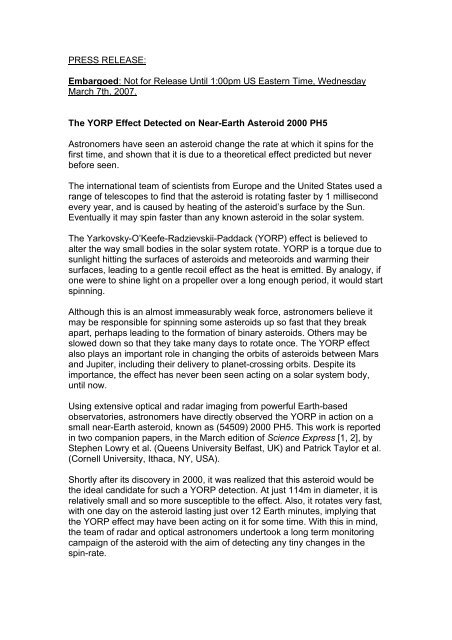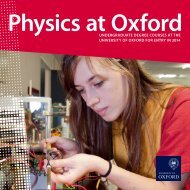PRESS RELEASE: Embargoed: Not for Release Until 1:00pm US ...
PRESS RELEASE: Embargoed: Not for Release Until 1:00pm US ...
PRESS RELEASE: Embargoed: Not for Release Until 1:00pm US ...
- No tags were found...
You also want an ePaper? Increase the reach of your titles
YUMPU automatically turns print PDFs into web optimized ePapers that Google loves.
<strong>PRESS</strong> <strong>RELEASE</strong>:<strong>Embargoed</strong>: <strong>Not</strong> <strong>for</strong> <strong>Release</strong> <strong>Until</strong> 1:<strong>00pm</strong> <strong>US</strong> Eastern Time, WednesdayMarch 7th, 2007.The YORP Effect Detected on Near-Earth Asteroid 2000 PH5Astronomers have seen an asteroid change the rate at which it spins <strong>for</strong> thefirst time, and shown that it is due to a theoretical effect predicted but neverbe<strong>for</strong>e seen.The international team of scientists from Europe and the United States used arange of telescopes to find that the asteroid is rotating faster by 1 millisecondevery year, and is caused by heating of the asteroid’s surface by the Sun.Eventually it may spin faster than any known asteroid in the solar system.The Yarkovsky-O’Keefe-Radzievskii-Paddack (YORP) effect is believed toalter the way small bodies in the solar system rotate. YORP is a torque due tosunlight hitting the surfaces of asteroids and meteoroids and warming theirsurfaces, leading to a gentle recoil effect as the heat is emitted. By analogy, ifone were to shine light on a propeller over a long enough period, it would startspinning.Although this is an almost immeasurably weak <strong>for</strong>ce, astronomers believe itmay be responsible <strong>for</strong> spinning some asteroids up so fast that they breakapart, perhaps leading to the <strong>for</strong>mation of binary asteroids. Others may beslowed down so that they take many days to rotate once. The YORP effectalso plays an important role in changing the orbits of asteroids between Marsand Jupiter, including their delivery to planet-crossing orbits. Despite itsimportance, the effect has never been seen acting on a solar system body,until now.Using extensive optical and radar imaging from powerful Earth-basedobservatories, astronomers have directly observed the YORP in action on asmall near-Earth asteroid, known as (54509) 2000 PH5. This work is reportedin two companion papers, in the March edition of Science Express [1, 2], byStephen Lowry et al. (Queens University Belfast, UK) and Patrick Taylor et al.(Cornell University, Ithaca, NY, <strong>US</strong>A).Shortly after its discovery in 2000, it was realized that this asteroid would bethe ideal candidate <strong>for</strong> such a YORP detection. At just 114m in diameter, it isrelatively small and so more susceptible to the effect. Also, it rotates very fast,with one day on the asteroid lasting just over 12 Earth minutes, implying thatthe YORP effect may have been acting on it <strong>for</strong> some time. With this in mind,the team of radar and optical astronomers undertook a long term monitoringcampaign of the asteroid with the aim of detecting any tiny changes in thespin-rate.
Over a 4 year time span, Stephen Lowry, Alan Fitzsimmons and colleaguestook images of the asteroid at a range of telescope sites including the 8.2mVery Large Telescope array and the 3.5m New Technology Telescope of theEuropean Southern Observatory in Chile, the 3.5m telescope at Calar Alto,Spain, along with a suite of other telescopes from the Czech Republic, theCanary Islands, Hawaii, Spain and Chile. With these facilities the astronomersmeasured the slight brightness variations as the asteroid rotated.Over the same time period, the radar team led by Patrick Taylor and Jean-LucMargot of Cornell University employed the unique capabilities of the AreciboObservatory in Puerto Rico and the Goldstone radar facility in Cali<strong>for</strong>nia toobserve the asteroid by ‘bouncing’ a radar pulse off the asteroid andanalyzing its echo. With this technique astronomers can reconstruct a 3-Dmodel of the asteroid’s shape, with the necessary detail to allow a theoreticalYORP value to be derived and compared with the actual observed spin-ratechange seen at optical wavelengths.With careful analysis of the optical data, the asteroid’s spin rate was seen tosteadily increase with time, at a rate that can be explained by YORP theory.Critically, the effect was observed year after year. Furthermore, this numberwas elegantly supported via analysis of the combined radar and optical data,as it was required that the asteroid be increasing its spin-rate at exactly thisrate in order <strong>for</strong> a satisfactory 3-D shape model to be determined.To predict what will happen to the asteroid in the future, Lowry et al.per<strong>for</strong>med detailed dynamical computer simulations using the measuredstrength of the YORP effect and the detailed shape model. They found that itsorbit about the Sun could remain stable <strong>for</strong> up to 35 million years in the future,allowing the spin-rate to be reduced to just 20 seconds, faster than anyasteroid spin-rate ever seen by astronomers. This exceptionally fast spin-ratecould <strong>for</strong>ce the asteroid to reshape itself or even split apart, leading to thebirth of a new binary system.
LIST OF FIGURES AND MOVIES:Fig 1: Asteroid 2000 PH5 imaged at optical wavelengths using ESO’s 3.5mNew Technology Telescope in Chile on August 27, 2003. The asteroid can beseen moving relative to the background stars (source: S. Lowry).Fig 2: Radar images obtained at the Arecibo facility in Puerto Rico on July 28,2004, covering one full rotation of asteroid 2000 PH5 (columns 1 and 4).Corresponding shape-model fits to the images are shown in columns 2and 5. Columns 3 and 6 are detailed 3-D renderings of the shape model itself(from Taylor et al. [2]).Fig 3: The observed spin-rate was seen to change from year to year (blackdots). The solid curve is the expected theoretical YORP strength derived fromthe 3-D shape model (from Lowry et al. [1]).Movie 1: This movie shows the asteroid moving against the background starsand galaxies over a period of 2 hours in September 2004. Rapid brightnessmodulations can be seen as the asteroid rotates. Obtained at the ESO 8.2mVLT array in Chile (source: A. Fitzsimmons).[Available at http://star.pst.qub.ac.uk/~scl/VLT_PH5movie/2000ph5b.mov]NOTES:[1] Stephen C. Lowry, Alan Fitzsimmons, Petr Pravec, David Vokrouhlicky,Hermann Boehnhardt, Patrick A. Taylor, Jean-Luc Margot, Adrian Galad, MikeIrwin, Jonathan Irwin, and Peter Kusnirak (2007). Direct Detection of theAsteroidal YORP Effect, Published online in Science Express(www.sciencemag.org).[2] Patrick A. Taylor, Jean-Luc Margot, David Vokrouhlicky, Daniel J.Scheeres, Petr Pravec, Stephen C. Lowry, Alan Fitzsimmons, Michael C.Nolan, Steven J. Ostro, Lance A. M. Benner, Jon D. Giorgini, ChristopherMagri (2007). Spin Rate of Asteroid (54509) 2000 PH5 Increasingdue to the YORP Effect, Published online in Science Express(www.sciencemag.org).
MORE INFORMATION:This work was based on observations at the following observatories:[OPTICAL FACILITIES] - The 8.2m VLT array (Antu) and the 3.5m NTT of theEuropean Southern Observatory (ESO), Chile (Programmes 271.C-5023 and073.C-0137); The 2.2m at La Silla Observatory (ESO and the Max-PlanckInstitut fur Astronomie); The Ondrejov Observatory of the AstronomicalInstitute of the Academy of Sciences of the Czech Republic (GrantA3003204); The Centro Astronomico Hispano Aleman (CAHA) at Calar Alto,operated jointly by the Max-Planck Institut fur Astronomie and the Instituto deAstrofisica de Andalucia (CSIC); The Liverpool Telescope is operated on theisland of La Palma by Liverpool John Moores University at the Observatoriodel Roque de los Muchachos (ORM) of the Instituto de Astrofisica deCanarias (IAC); The Isaac Newton Telescope is operated on La Palma by theIsaac Newton Group at the ORM; The Faulkes Telescope North is part of theLas Cumbres Observatory Global Telescope Network.[RADAR FACILITES] - The Arecibo Observatory, Puerto Rico and theGoldstone Solar System Radar, Cali<strong>for</strong>nia. The Arecibo Observatory is part ofthe National Astronomy and Ionosphere Center, which is operated by CornellUniversity under a cooperative agreement with the National ScienceFoundation. The Deep Space Network (DSN) is a facility of NASA, and ismanaged <strong>for</strong> NASA by the Jet Propulsion Laboratory, a division of theCali<strong>for</strong>nia Institute of Technology.CONTACTS:Stephen LowryAstrophysics Research CentreQueen’s University BelfastBT7 1NN, UK.Phone: +44 28 9097-3692Email: s.c.lowry@qub.ac.ukPatrick TaylorCornell UniversityDepartment of AstronomyIthaca, NY 14853-6801, <strong>US</strong>A.Phone: +1 607-255-2727Email: ptaylor@astro.cornell.eduAlan FitzsimmonsAstrophysics Research CentreQueen’s University BelfastBT7 1NN, UK.Mobile Phone: +44 7834-318834Email: a.fitzsimmons@qub.ac.uk
Jean-Luc MargotCornell UniversityDepartment of AstronomyIthaca, NY 14853-6801, <strong>US</strong>A.Phone: +1 607-255-1810Email: jlm@astro.cornell.eduHermann BoehnhardtMax-Planck Institute <strong>for</strong> Solar System ResearchMax-Planck-Str. 2D-37191 Katlenburg-LindauGermany.Phone: +49 5556-979-545Email: boehnhardt@mps.mpg.dePetr PravecAstronomical Institute AS CRCZ-25165 OndrejovCzech RepublicPhone: +420 323-620352, +420 737-322815Email: ppravec@asu.cas.cz, suchan@astro.czFIGURES:Figure 1.
Figure 2.
Figure 3:Movie 1:[Available at http://star.pst.qub.ac.uk/~scl/VLT_PH5movie/2000ph5b.mov]




